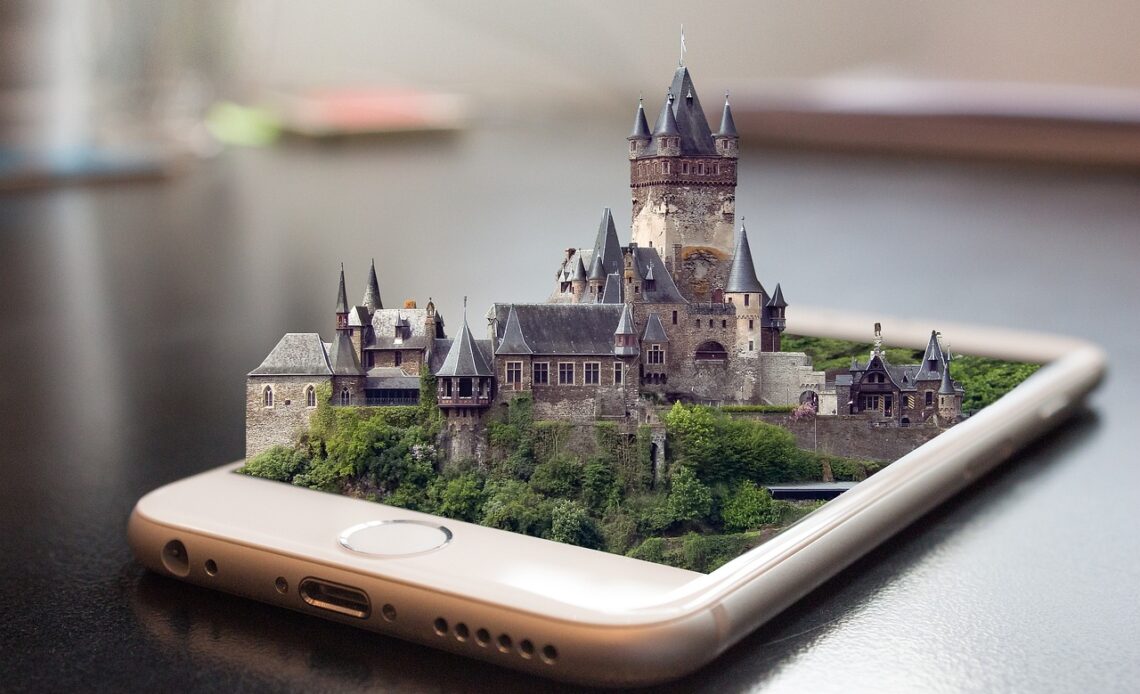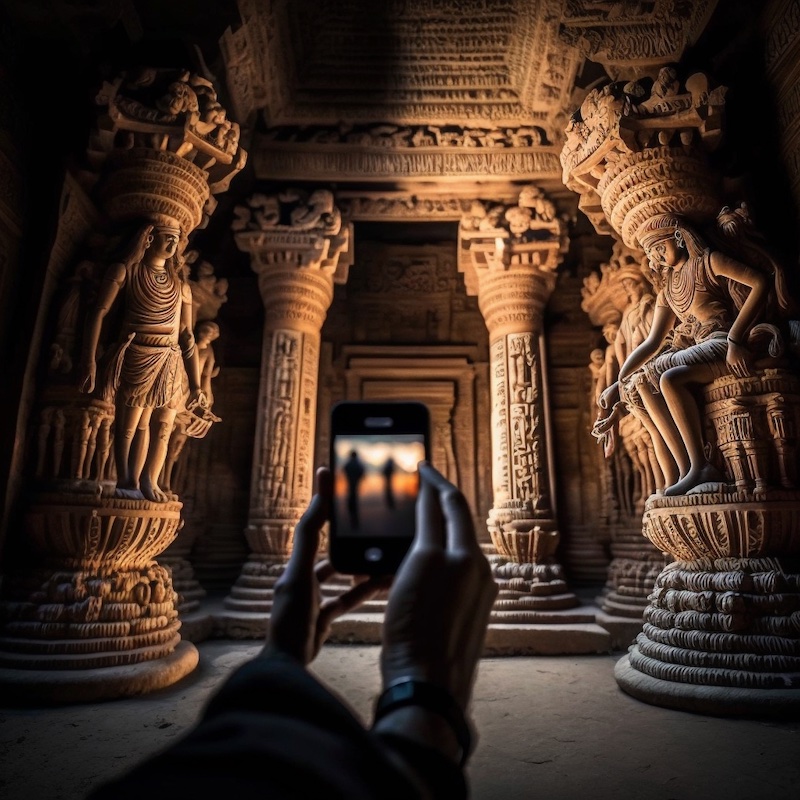
Creating an AR experience is accessible to everyone, but there are some keys steps to follow.
Crédits photos : Pixabay
The emergence of Location-based Augmented Reality promises to transform the very fabric of our lives, offering unparalleled opportunities to revolutionize the way we engage with the world and interact with each other. As John Hanke, CEO of Niantic, Inc puts it, “Location-based AR has the potential to change the way we experience our cities and the world around us.” This new technology allows for truly immersive and interactive experiences, as Snap Inc’s CEO Evan Spiegel describes, “Location-based AR is the next frontier in storytelling” and as the Co-founder of the Augmented Reality Consortium, Ori Inbar, states “Location-based AR will change the way we interact with our environment and each other.”
What is Location-based AR?
Location-based Augmented Reality refers to the integration of digital information, such as 3D models, text, and other interactive elements, into the physical world using a device such as a smartphone, tablet, or a headworn device. These experiences are linked to a specific location and can be accessed or activated when the user is in that location. It allows users to layer virtual elements onto the real-world environment, enhancing and enriching their understanding of their surroundings.
This can range from interactive tours of historical sites to games that use real-world locations as the playing field, to advertising that targets users based on their location. Location-based AR experiences enable users to bridge the gap between the digital and physical worlds in a way that is contextually relevant and enhances the real-world experience.
Location-based AR experiences can be currently built using Google’s ARCore, Niantic/8th Wall VPS, and Snap’s Custom Landmarker technologies. At Atomic Digital Design, we’ve created over 10 Location-based Augmented Reality experiences and I wanted to share everything we’ve learned building them. I’ve separated them into the following categories: Scanning, Design, Development, QA and Testing, and Publish and Marketing.
Scanning: The First Step for a Successful Project
Scanning locations for augmented reality (AR) is the first essential step in creating interactive and immersive AR experiences. One of the most important things to keep in mind when scanning a location is to make sure that your device is connected to the internet. Without an internet connection, the scan won’t be usable since it won’t be able to connect with the phone’s GPS.
The position in which you open the lens for scanning is also crucial. This position will act as the reference point for placing the mesh. Therefore, try to open the scanning application in front of the position you want the users to scan the building, statue, or another object.
Another important aspect to consider when scanning locations for AR is the weather, time of day, obstructions, and lighting. The ideal condition for scanning a location is a clear day with bright, natural light. Avoid scanning locations on cloudy days or at night when lighting is poor. Also, be aware of any obstructions that might affect the quality of the scan, such as trees, cars, or people.
When scanning a location, it’s important to move your body in different directions and change your orientation and angle. Stand about 5 feet from your target object and walk around it for 30 seconds to 1 minute, while keeping the target in view. This will allow the camera to capture multiple perspectives and angles of the object, resulting in a more accurate and detailed scan.

Design: Crafting a Seamless User Experience
Before you start designing the AR experience, it’s important to know what you want to achieve. Is the goal to entertain, educate, or promote a product or service? Understanding the purpose of the experience will help you make decisions about what elements to include and how to design them.
The location you choose for your AR experience is crucial. It should be a place that is easily accessible and has enough space for users to move around and interact with the AR elements. Also, consider the type of environment and the audience you want to target. For example, a historical monument might be a suitable location for an educational experience, whereas a shopping mall might be a better location for a promotional experience.
A well-crafted story or theme can engage users and make the experience more immersive. Consider the history, culture, and characteristics of the location and use them to create a story that is relevant and interesting to users.
AR experiences should be interactive and engaging. Consider adding elements such as puzzles, games, or quizzes that users can play and solve. This way they can be involved in the experience and actively engage with it.
Designing location-based augmented reality experiences is not only about creating visually stunning and engaging content, it’s also about ensuring user safety. As we bring digital experiences into the physical world, it’s crucial to consider how users will navigate and interact with both the digital and real-world environments. By designing with user safety in mind, we can create truly seamless and enjoyable experiences that enhance our connection to the world around us, rather than detract from it. From ensuring the visibility of real-world obstacles to providing clear instructions for interacting with digital elements, the key to successful location-based AR design is to strike a balance between the digital and physical worlds. Be aware of potential safety concerns for the user including cars, other pedestrians, uneven floors, and other potentially dangerous obstacles.
We have found that, when possible with budget and time, it’s best to create a non-VPS mode for everyone who could get value from the AR experience even without being on-site. While it may not provide the same level of immersion as the full VPS-enabled experience, it can still offer valuable content and reach a wider audience who may not have access to the physical location.
Development
One of the main features of a location-based AR experience is the ability to use location data to trigger AR content. This requires a solid understanding of geolocation and mapping technologies such as GPS, VPS, beacons, etc. Additionally, it’s important to consider how to handle different levels of accuracy and availability of location data based on the devices the users are using.
Location-based AR experiences often involve downloading large 3D assets and media files over a 4G/5G connection. Therefore, it is important to optimize the data transfer and reduce the load on the network as much as possible. This can be done by using techniques such as data compression, caching, and server-side optimization.
It’s going to be really important to start testing your VPS code before you go to the site which might be in your city and reachable, or could be on the other side of the planet. That’s why it’s really important to create a VPS wayspot in the office, ideally by your desk. With 8th Wall, you can make them private so you don’t need to worry about sharing the scans with everyone else.
As much as you can prepare beforehand, there are going to need to be changes made once you do the experience on-site. I’ve brought my computer to various sites in Paris including the Obelisk and the Louvre Pyramids. I was very lucky that the Louvre is one of my stops to and from work and it only took me 5-10 minutes to get up and do more scanning and testing. I went 5+ times before its tracking was successful.
Testing and Iteration: The Path to Perfection
No AR experience can be deemed complete without thorough testing and iteration. Testing in a controlled environment is essential, but it’s also important to test in the real world, under varying conditions. This will help you identify any issues or challenges that users might face and ensure that the experience works well across different devices, weather conditions, and times of day.
Involve users in the testing process by conducting user tests and gathering feedback on their experience. This will help you understand what works, what doesn’t, and how you can improve the overall experience. Be prepared to iterate and make adjustments based on user feedback and your own observations.
Marketing and Promotion: Driving User Engagement
An engaging and well-designed AR experience is only as successful as the number of people who use it. That’s why marketing and promotion are essential components of building location-based AR experiences. Leverage social media, press releases, and influencer marketing to spread the word about your experience. Engage with local communities, businesses, and organizations that may be interested in your AR experience, and collaborate with them to promote it.
Measurement and Analytics: Understanding Your Impact
Finally, it’s crucial to measure the success of your AR experience using analytics tools. This will help you understand how users are interacting with your experience and identify areas for improvement. Some key metrics to track include the number of users, session duration, user engagement, and retention.
By analyzing these metrics, you can gain valuable insights into user behavior and preferences, which can help you optimize the experience and drive better results. In addition, you can use this data to demonstrate the success of your AR experience to stakeholders, clients, and partners, ensuring continued investment and support for your projects.
Location-based AR presents an extraordinary opportunity to transcend the boundaries of our physical world, seamlessly weaving the digital realm into our everyday lives. As architects of this brave new frontier, it is our privilege and responsibility to create engaging, immersive, and successful experiences that resonate with the hearts and minds of our users. By following these five lessons, you can create immersive, and successful experiences that capture the attention and imagination of users and have the world be your canvas.

